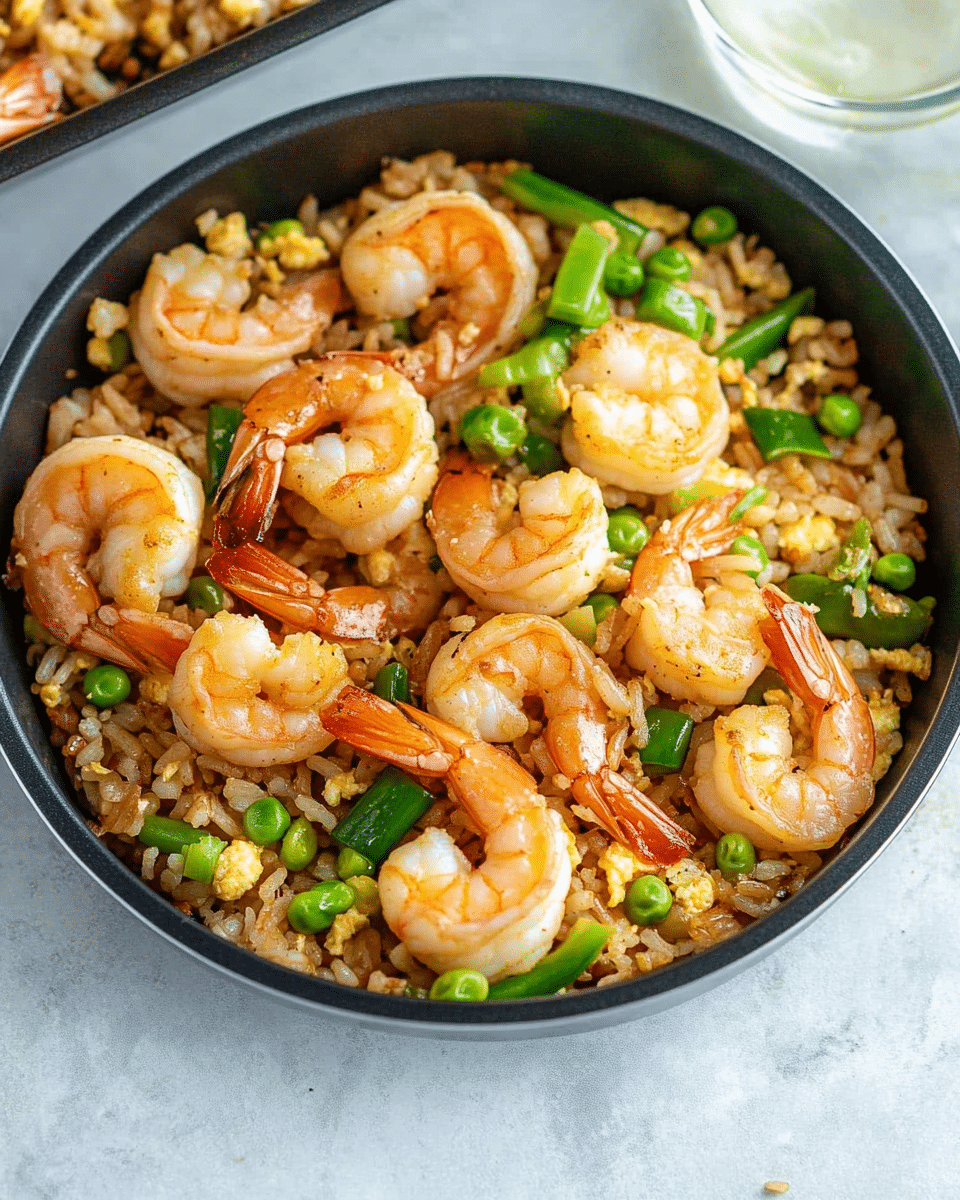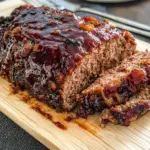Hibachi Shrimp with Fried Rice brings the sizzling magic of a Japanese steakhouse right to your dinner table. With plump, juicy shrimp seared in garlic butter and finished with a touch of soy and lemon, every bite is bursting with umami goodness. The accompanying fried rice, laced with vegetables and savory scrambled eggs, completes the dish with comfort and flavor.
What makes this recipe especially amazing is its simplicity, minimal ingredients, quick prep, and a skillet is all you need to recreate your favorite hibachi experience. Whether you’re cooking for family, hosting friends, or simply treating yourself, this satisfying dish is sure to become a go-to weeknight favorite. Customize it with extra sauces or spice it up with chili flakes for a bold twist.
Full Recipe:
Ingredients:
For the Shrimp:
-
1 lb large shrimp, peeled and deveined
-
1 tbsp sesame oil
-
1 tbsp soy sauce
-
1 tbsp butter
-
2 cloves garlic, minced
-
Salt and pepper to taste
-
1 tbsp lemon juice
For the Fried Rice:
-
3 cups cooked jasmine rice (preferably day-old)
-
2 eggs, lightly beaten
-
2 tbsp soy sauce
-
1 tbsp butter
-
1 cup frozen mixed vegetables (peas, carrots, corn)
-
2 green onions, sliced
-
1 tbsp sesame oil
-
Salt and pepper to taste
Directions:
-
Prepare the Shrimp: In a large skillet or hibachi grill pan, heat sesame oil over medium-high heat. Add butter and garlic, and sauté for 30 seconds.
-
Add shrimp, season with salt and pepper, and cook for 2-3 minutes per side or until pink and opaque.
-
Drizzle with soy sauce and lemon juice. Toss well and cook for another minute. Remove shrimp from the pan and set aside.
-
Prepare the Fried Rice: In the same skillet, heat butter and sesame oil. Add frozen mixed vegetables and cook for 2 minutes.
-
Push veggies to the side and scramble eggs in the center. Once cooked, combine with vegetables.
-
Add in cooked rice and soy sauce. Stir well to combine and cook for 3-4 minutes, stirring occasionally.
-
Add green onions and adjust salt and pepper to taste.
-
Serve shrimp over a bed of fried rice and garnish with extra green onions or sesame seeds if desired.
Prep Time: 10 minutes | Cooking Time: 20 minutes | Total Time: 30 minutes
Kcal: 420 kcal | Servings: 4 servings
Hibachi Shrimp with Fried Rice: A Japanese Steakhouse Experience at Home
There’s something incredibly comforting about sitting at a Japanese steakhouse, the sizzle of the griddle, the clanging of spatulas, the chef’s swift movements, and the mouthwatering aromas rising from the hot hibachi grill. While the show is half the experience, it’s the food, especially the perfectly cooked shrimp paired with buttery fried rice, that leaves a lasting impression. Fortunately, you don’t have to go out to enjoy that kind of magic. This Hibachi Shrimp with Fried Rice recipe brings the full flavor and excitement of the teppanyaki experience to your kitchen, minus the expensive restaurant bill or wait time.
Why You’ll Love This Dish
Hibachi shrimp with fried rice is an ideal recipe for busy weeknights, special occasions, or anytime you want to impress without fuss. Shrimp cooks quickly, making this a 30-minute meal that feels indulgent but is remarkably easy to prepare. The dish is naturally protein-rich, gluten-friendly (if you use gluten-free soy sauce), and incredibly adaptable to what you already have on hand.
The combination of garlic, butter, sesame oil, and soy sauce deliver a deep umami taste that coats every bite of tender shrimp. Meanwhile, the fried rice, enhanced with scrambled eggs, crisp vegetables, and fragrant green onions, brings balance to the plate. The duo is a match made in culinary heaven, providing both texture and flavor in a single satisfying meal.
A Brief Dive into Hibachi & Teppanyaki Cooking
While the terms are often used interchangeably in the West, hibachi and teppanyaki refer to different types of Japanese cooking methods. Traditionally, hibachi refers to a small, portable grill used for open-flame cooking, while teppanyaki involves cooking on a flat iron griddle (teppan). Most Japanese steakhouses in the U.S. use teppanyaki-style cooking, which is where the performance aspect, knife tricks, onion volcanoes, shrimp-tossing, comes in.
This recipe draws inspiration from teppanyaki-style hibachi restaurants, focusing on the flavor profile that has made them so beloved: a savory, slightly smoky, garlic-butter-rich taste with crisp veggies and perfectly seasoned rice.
Tips for the Best Hibachi Shrimp and Fried Rice
Here’s how to elevate your homemade hibachi meal to restaurant-quality:
1. Use Day-Old Rice
Freshly cooked rice tends to be too moist and sticky, which can lead to mushy fried rice. Using rice that’s been refrigerated overnight allows it to dry slightly, helping it fry beautifully and develop that slightly crispy texture on the edges.
2. Cook Shrimp Separately
Shrimp cook very quickly, usually in 4–6 minutes total. To avoid overcooking them, prepare your shrimp in a separate pan (or remove them from the skillet once done) before adding the rest of your fried rice ingredients.
3. Use High Heat
Hibachi cooking relies on high heat to quickly sear ingredients, locking in moisture and enhancing flavor. Use a large skillet, griddle, or wok over medium-high to high heat for that signature char and flavor.
4. Don’t Overcrowd the Pan
For the best texture, especially in the fried rice, avoid overcrowding your pan. This ensures your ingredients get fried—not steamed. If doubling the recipe, cook in batches.
5. Butter Is Key
While sesame oil adds that traditional Japanese aroma, it’s the butter that creates the signature creamy mouthfeel and depth in hibachi cooking. Don’t skimp!
6. Garnish with Sesame Seeds or Extra Scallions
For presentation and an extra crunch, a sprinkle of toasted sesame seeds or freshly chopped scallions goes a long way.
Ingredient Breakdown
Here’s a closer look at the core components of this recipe:
Shrimp:
Lean, quick-cooking, and full of flavor, shrimp are an excellent source of protein. Medium to large shrimp work best for hibachi cooking. Make sure they are peeled, deveined, and patted dry to ensure a good sear.
Rice:
Jasmine rice is aromatic and slightly sticky, making it perfect for fried rice. Day-old rice is essential for achieving the right texture.
Vegetables:
A simple frozen mix of carrots, peas, and corn works wonderfully and keeps things quick. You can also incorporate diced zucchini, onions, or mushrooms if you’re feeling adventurous.
Soy Sauce:
Adds saltiness and umami. For a gluten-free version, use tamari or coconut aminos.
Garlic:
Minced garlic adds a fragrant and savory punch to the shrimp. It’s one of the defining ingredients in hibachi-style dishes.
Butter & Sesame Oil:
These two fats balance each other perfectly, one creamy and rich, the other nutty and aromatic. Together, they form the base of hibachi-style cooking.
Pairing Ideas
This dish can stand on its own but also pairs well with:
-
Miso Soup or Clear Soup – A light, umami-rich starter
-
Ginger Salad – Lettuce, shredded carrots, and cucumber with a tangy ginger dressing
-
Yum Yum Sauce – A creamy, slightly sweet hibachi-style sauce that’s great for dipping shrimp or drizzling over rice
-
Japanese Pickles (Tsukemono) – For a tangy, crunchy contrast
Storage & Reheating
If you have leftovers, you’re in luck, hibachi shrimp and fried rice make for fantastic next-day meals.
-
Storage: Keep in an airtight container in the fridge for up to 3 days.
-
Reheating: Heat in a skillet over medium heat with a splash of water or broth to rehydrate the rice. Avoid microwaving shrimp for too long, as it can turn rubbery.
Dietary Adjustments
-
Low-Carb/Keto: Swap rice for cauliflower rice and use coconut aminos instead of soy sauce.
-
Gluten-Free: Ensure your soy sauce is gluten-free, or use tamari.
-
Dairy-Free: Replace butter with plant-based alternatives or more sesame oil.
Conclusion
Hibachi Shrimp with Fried Rice is more than just a meal, it’s an experience. It brings the rich, sizzling flavors of Japanese teppanyaki straight to your kitchen with minimal effort and maximum taste. The buttery shrimp, savory garlic notes, nutty sesame undertones, and colorful vegetables all come together in a harmony of flavors and textures that feel indulgent yet accessible.
Whether you’re recreating your favorite restaurant dish, looking to elevate your dinner routine, or simply want a crowd-pleasing recipe to share, this dish delivers. With its easy ingredients, short prep time, and stunning results, it’s no wonder this hibachi classic is loved by many, and now, you can make it a staple in your own home.






